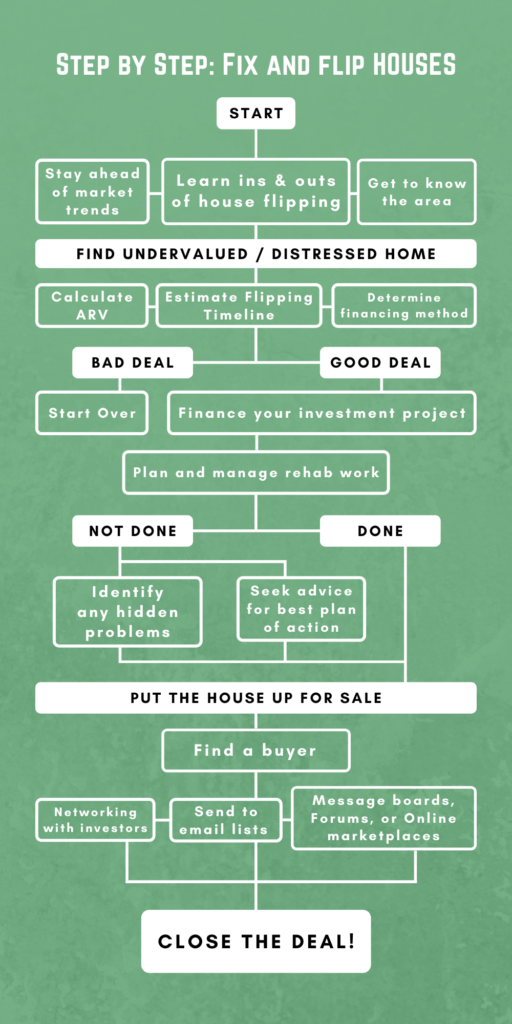With the passage of time, more and more real estate agents are investing in house flipping projects – and for obvious reasons.
However, you should never forget that as rewarding as this investment may be, it also involves several risks. Of course, every investor wants to see a great house flipping profit margin but is that so easy?
Well, not really.
Successful house flipping isn’t merely about buying a cheap house, renovating it, and then selling it for good money. Several things can go wrong if you aren’t diligent throughout the process. Every step in this risky journey should be taken with focus on the end goal — to maximize your profit margin on the deal.
If you’re just beginning or perhaps struggling on your house flipping journey, you’ve come to the right place! Here’s a list of some of the most helpful tips and tricks to maximize your house flipping profit margin.
1. Make Property Inspection a Must
When it comes to buying a house for flipping, an impulsive purchase is a big NO! You must inspect a property before making a deal no matter what. Many investors buy an unseen property only to realize later that it needs major repairs and renovations.
Inspecting a house before making a purchase allows you to make up your mind regarding your budget for repairs. You will get a chance to plan a careful and detailed budget before you apply for financial assistance. Moreover, you will also get to know an accurate estimation of the amount you may need to spend on a property before you sell it for a good profit.
2. Say No to a Damaged House
If you want to maximize your house flipping profit margin, you would want to focus on buying properties that need only minor cosmetic improvements. A house with a damaged roof or poor electrical systems will not only require a huge sum of money for its repair and renovation but it will also decrease your chances of earning a good profit.
So, the rule of the thumb is to say no to houses with foundation problems and look for houses that can be turned into a new-looking property with as minor changes as refinished floors, a new coat of paint on the walls, and replaced appliances.
3. Calculate Your Profit Margin
Another simple trick to enjoying maximum house flipping profit margin is to map it out beforehand. You must have a clear idea of your profit margin so that you may weigh it against your repair costs. You may also want to consider the expense of your time and mental energy required in the house-flipping project when calculating your profit margin.
4. Be Prepared for Multiple Outcomes
As mentioned earlier, house flipping is a risky investment. While your aim is to repair the property and sell it as fast as possible, certain obstacles may come in your way. A change in the real estate market or the overall economy may negatively affect your chances of earning a big profit on the flipped property. You may realize that you have spent way more than your budget allowed or overestimated the sales price of the house. It is also possible that you miss your project completion deadline. All these factors can lower your house flipping profit margin.
In such unforeseen and unpleasant circumstances, you can either offer the property for rent or suffer a loss. What would you prefer? Make sure you have backup exit strategies in mind to ensure that you can turn your loss into a long-term income stream.
5. Know Who the Buyer is
When you have an idea of who is going to buy the flipped property from you, you can know what to expect from them. You can also get an idea of their price point, which you may then use as a standard while planning renovations and repairs for the property. You wouldn’t want to spend so much on a property that you know no one in the area will be willing to spend money on, right?
6. Partner With a Good Contractor
If you’re new in the house flipping game, you would want to take the assistance of an experienced contractor and property inspector. Qualified partners will ensure careful inspection and accurate estimation of repair costs based on what the property actually needs. Having a good team backing you up, you can increase your chances of maximizing your house flipping profit margin.
7. Always Start Small
As a beginner, you should always limit yourself to smaller projects. Never jump into something too big – buying a large property involving large costs of repairs is a huge risk. Starting small and then gradually climbing up the ladder is the key to becoming a successful house flipper. As an amateur in the fix and flip business, you should consider looking for single-family houses that don’t need major improvements.
8. Choose the Market Smartly
Selecting the right market is perhaps the biggest prerequisite to maximizing your house flipping profit margin. If you step into the wrong market, you will lose your very first deal just like that. Understanding the market will help you in two ways. For one, you will get a fair idea of how much you should spend on upgrades to not go overboard. Secondly, it will help you know if prospective buyers are waiting to purchase the finished property.
9. Stay Organized
To make sure you stay on top of the whole process, consider getting a good CRM. Knowing how to use it efficiently will help you stay organized and ensure that everything is on track. Following a strict schedule will further help you prevent unnecessary hassle due to emergencies and unexpected scenarios.
10. Look for Developing Neighborhoods
A smart way of maximizing your house flipping profit margin is by buying cheap property in an up-and-coming area that is likely to grow in the future. Keeping the future development plans of a neighborhood in mind while doing research can help you secure the ideal property for a successful flip.

11. Add Inexpensive Yet High-end Features
You should aim to add some high-end features to your property while making sure you stay within your budget. certain renovations look more expensive than they really are – and they are exactly what can help you earn top dollar for your property.
12. Educate Yourself
Understanding the ins and outs of house flipping is essential to securing a good house flipping profit margin. You should consider taking necessary real estate courses, reading books, and surfing the internet to get familiar with the business. You won’t transform from being a beginner to a professional house flipper in a matter of days – there’s a lot to learn on the way.
13. Choose the Right Lender
When you’re looking for ways to fund your house flipping project, borrowing money from a hard money lender may seem like a good option. That being said, contemporary lenders usually require the perfect credit history and even if you have good credit in your name, they tend to take a considerable amount of time before handing over the money. Thus, you should consider choosing a lender who works with house flippers on a routine basis and doesn’t have a complicated application process. Always go for a lender who asks for a small down payment and offers a quick turnaround time.
14. Set a Fair Price for Your Property
To make a quick sale, you should focus on pricing the property correctly. You may get tempted to overprice it in an attempt to gain maximum house flipping profit margin but it’ll be one of the biggest mistakes you can make in the house flipping business. An overpriced house won’t sell let alone sell quickly. If you price the property for nothing more than it actually deserves, you’ll start getting offers within the first week of putting it up on the market.
15. Build Your Network
As a beginner in the house flipping market, you should consider joining your local real estate investing club and social media groups. This way you’ll surround yourself with expert real estate investors who have a wealth of experience doing what you’re just starting to do. You will get a chance to learn from their experience and get all your questions answered. With this knowledge base, you’ll find it easier to maximize your house flipping profit margin.
Learn More…
Learn more about the 10 best states to flip a house here>
Want to lay a strong foundation for your house flipping business? Discover the most common mistakes of real estate investors that make their house flipping projects a flop here.

